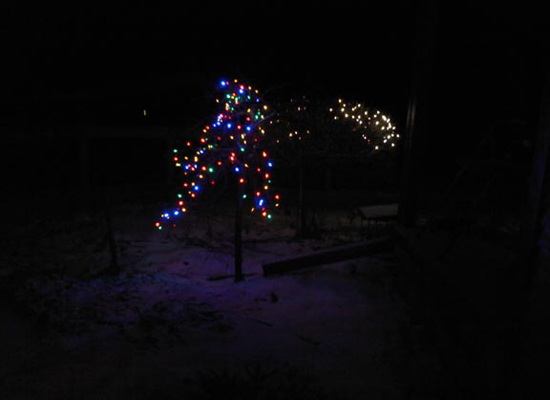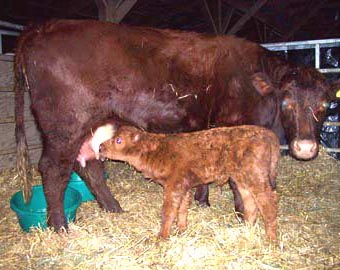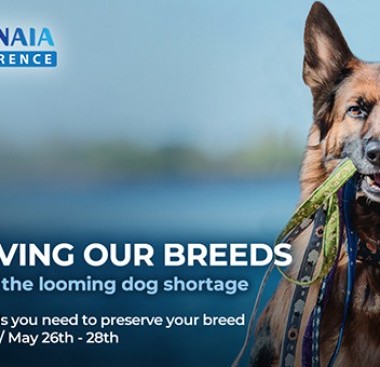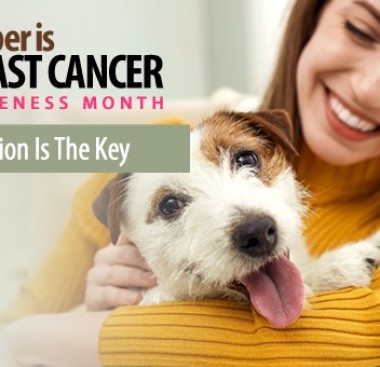The Red Cow: Calves of Winter
By: Lana Kaiser Date: 02/25/2012 Category: | Animal Agriculture | Animal Welfare |
Christmas Lights
 I leave the Christmas lights on the Japanese pea tree all year long - when I get up in the middle of the night to check my cows they make me smile. Then I almost feel good about dragging my sorry butt out of bed at 3 am and walking to the barn - trying not to really be awake in case nothing is going on and I can go back to sleep, but being awake enough not to slip on the ice, fall into a snow bank or trip over a sleeping heifer. It's a balancing act. Everything about raising cattle is a balancing act.
I leave the Christmas lights on the Japanese pea tree all year long - when I get up in the middle of the night to check my cows they make me smile. Then I almost feel good about dragging my sorry butt out of bed at 3 am and walking to the barn - trying not to really be awake in case nothing is going on and I can go back to sleep, but being awake enough not to slip on the ice, fall into a snow bank or trip over a sleeping heifer. It's a balancing act. Everything about raising cattle is a balancing act.
The bred heifers (2 year old pregnant females) and some of the cows are due to calve in January. The gestation of cattle is similar to humans - about 9 months. Since we use artificial insemination (AI) to breed all our females, we have due dates for every heifer and cow, but of course Mother Nature doesn't always read the book. As we get closer to the due date we put them up into a big deeply bedded pen in the barn at night. Having them up in the barn makes it easier to check on them at night and helps to ensure that the calves are born in a clean dry environment.
If you watch your cows you get a sense when they are getting closer to calving - things change. The pelvic ligaments get loose and the udder begins to fill; they do a lot of tail swishing, they may get up and down a lot or act uncomfortable. Subtle changes in the udder is something I pay a lot of attention to - a wrinkly udder in the morning that is full and tense at noon signals an impending birth. Cattle are prey animals so they don't really want to advertise that they are about to calve. Even when you know your cows well and interact with them daily you notice that some cows are more secretive than others. They don't want you watching - they want to be left alone to do their job. Other cows don't seem to care. It helps to know your cows and how they react to know which cow may need assistance and which ones are fine and just want to be left alone.
Why get up in the middle of the night to check cows? Well, I am responsible for them - I made the breeding decisions, I decided they should calve in January, I decided who the sire (father) of the calf should be. I am responsible. A just born baby calf is wet and slimy and has just rudely arrived from a nice warm environment to (perhaps) minus 10 with a 30 mph wind. Despite wind blocks, and deep straw that is still cold - real cold. It doesn't take long for a wet baby calf to get cold and get in trouble - if that baby doesn't get dried off and nurse in a timely fashion that baby can freeze or be a set up for health problems down the line. Now a good mother cow will get that baby up and start licking her off and encouraging her to eat - but what happens if that baby is born and slides under a gate away from her mother? What happens if the mother is having twins and can't attend to baby number one while baby number 2 is being born? What happens if the foot is back (calves are normally born with both front feet forward and the head follows) and the baby can't be delivered? That is why I get up in the middle of the night to check on the cows.
So you head to the barn in the middle of the night. It is a beautiful night - the Christmas lights are bouncing in the wind, the sky is clear and the stars are huge and bright, and it is so cold your nose hairs freeze. What you really want in the middle of the night is nothing going on - cows lying around chewing their cud, cows sleeping, cows eating - what you really want is nothing going on so you can go back to bed and check on them again in the morning before you have your coffee.
Ziva
They say that if you feed your cows at night they will be more likely to calve during the day. I am a believer. Of course night and day are relative terms, is night when it is dark and day when it is light or do we base it on a time? Driving a tractor loaded with hay through the snow, over the icy rutty drives and fields is much safer in daylight and I prefer to feed cows when there is still some light. So as the days get longer the feeding gets later, and you think that yes there will be a spring.
It was dark out, and it wasn't all that long ago that I had fed the cows in the field and checked the close up cows in the barn. Close up cows are those that are due to calve in the "near future" - the cows in the barn were all at least 10 days from the "official due date" but they looked like they were going early. Sitting in the house a little voice said "go to the barn" - I always listen to the little voice.
One of the largest pains of calving in the winter (besides getting up in the middle of the night) is constantly changing clothes - you get cold, you get wet, you get dirty, you need something in the house - you find that despite having at least 80 layers on there appears to be straw in your underwear. Now there are barn clothes and then there are clothes that let you see what is going on and keep you warm but you wouldn't want to do cattle work in them - they are "semi good" clothes. The little voice always catches me in the semi good clothes.
As I approached the barn I heard a cow mooing - this was not a happy moo, it was not a moo signifying pain, it was a distressed moo. Something was wrong and the cow was disturbed. And then I saw Violet standing at a gate calling to the wet just born baby who has slid under the gate. There is no changing clothes - the priority is to get that baby back in the pen with her mother and if the clothes don't wash they can become barn clothes!
Cold and windy and not a perfect day to be a wet baby under a gate. Violet, a red first calf heifer, had her calf unassisted (without help) and because of where she chose to lie down, that baby just slid under the gate. Had I not listened to the little voice that calf would have been very cold in a very short period of time - cold not only affects the calf in the short term but also influences how they do in the long term.
The bovine placenta, unlike the human placenta, does not allow antibodies to pass from mother (the dam) to calf. Therefore a calf is born with virtually no immunity. The immunity is obtained from the first milk (colostrum) and the antibodies in the colostrum are absorbed thru little passageways in the intestines. Normally those passageways are closed by 48 hours after birth, so it is important that every calf get colostrum as soon as possible after birth. Colostrum is very efficiently absorbed in warm dry calves, but poorly absorbed in cold wet calves. And without immunity from colostrum calves are a set up for respiratory disease (pneumonia), diarrhea ("scours"), umbilical infection ("naval ill") and other infections.
But the cow, especially a heifer, needs time to interact and bond with her baby - so we need to balance the bonding with the calves other needs. Our wet under the gate calf was standing and wanting to nurse - we lead the pair to a smaller pen, out of the wind and deeply bedded with spelt straw. Violet begins to lick her calf and the calf immediately starts to nurse. I leave the pair to do their job.
Heifers, unlike cows, don't always know what they should be doing - some are so excited about their calf that they keep turning to look at the calf as the calf is trying to nurse, kind of a "heifer dance". Some are so desirous of cleaning that calf off with the sandpaper tongue that the calf loses her balance and falls into a pile of straw. In order for cattle to stand up they have to have their front legs bent and underneath them, so there may be some flailing around, which can make the heifer nervous. In a perfect world, in the first couple of hours after birth, the calf gets her legs, begins to nurse, gets cleaned off by her mother, and urinated and defecates. Seeing a calf bounce and frolic means the calf is well.
In the miserable cold weather it is prudent to make sure this calf is warm and dry - and so we do. Ziva, our new calf, is wet, her ears are cold and her belly isn't as warm as we would like. She has had colostrum but we want her warmer - so off she goes into the calf warmer. Violet who has worked pretty hard is content to eat and lie down while her calf is placed near by in the calf warmer.
 The calf warmer is the best investment a person who calves in the winter can make. But there are other ways to warm a calf - ranchers and cowboys across the country will put a cold calf on the passenger side of the pick up, in the house in front of the fireplace, in portable trailer with a heater, and yes calves have been warmed in the bathtub!
The calf warmer is the best investment a person who calves in the winter can make. But there are other ways to warm a calf - ranchers and cowboys across the country will put a cold calf on the passenger side of the pick up, in the house in front of the fireplace, in portable trailer with a heater, and yes calves have been warmed in the bathtub!
After a couple of hours in "the box" the calf is warm and dry and ready to rock and roll. When I let a warm dry bouncing Ziva out of "the box" to be reunited with Violet, I recall that Violet was born on a cold winter night and slipped under the gate - this time the little voice woke me up at 4 AM. Now I wonder, is gate sliding genetic?
About The Author
All Authors Of This Article: | Lana Kaiser |











